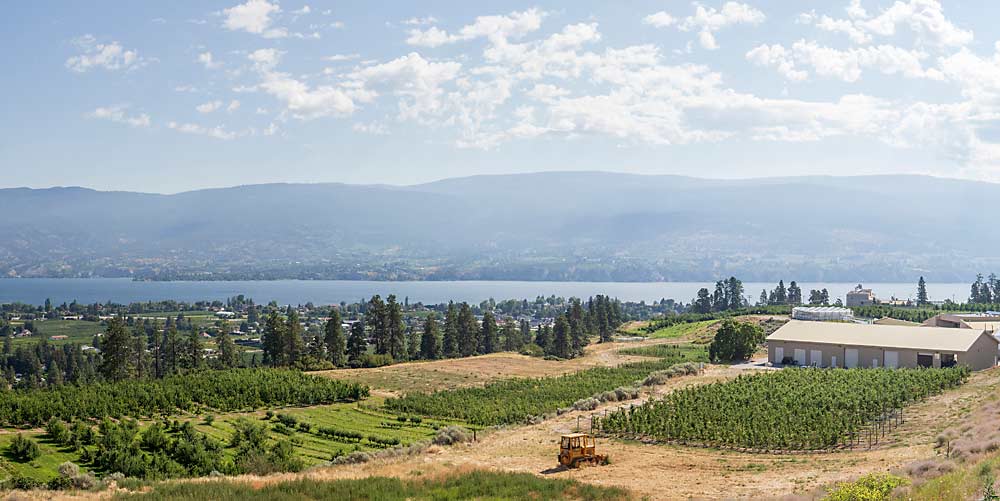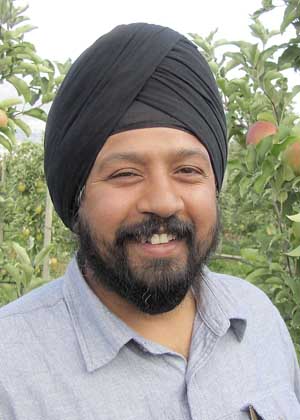
Amrit Singh proudly shows off test blocks of fruit trees on the 800-acre property that’s home to the Summerland Research and Development Centre, one of the key fruit breeding stations operated by Agriculture and Agri-Food Canada.
Best known as the home of Spartan apples, as well as Lapins, Staccato and Stella cherries, Summerland is a critical element in keeping growers in British Columbia’s Okanagan Valley, and across the Northwest, competitive.
Sweet cherries developed here have been fundamental to the rapid growth of plantings in British Columbia, helping growers stay competitive with Washington producers who can bring fruit to market earlier and at a scale that outstrips their own.
The challenge for Singh, who joined Summerland in 2017, is to advance research so that growers stay competitive well into the future. It’s no small task: Singh has been charged with filling the shoes of former apple breeder Cheryl Hampson as well as cherry specialist Frank Kappel, whose work bequeathed him test plots with approximately 32,000 potential new varieties.
A national mandate for apples means they’re a higher priority, representing about 70 percent of Singh’s work. Summerland has 250 selections that have advanced beyond initial evaluations.
Sweet cherries, largely a British Columbia crop in Canada, absorb just 30 percent of his time. The test orchard has about 20 selections at the second level of testing.
To help him manage both programs, and make the selection process more efficient, Singh has a mandate to introduce new technology aimed at streamlining a conventional breeding process that typically puts 25 years of research into each new apple variety.

“The breeding program has a history of very successful breeders,” Singh said, listing his predecessors backward in time from Hampson and Kappel through Harvey Quamme, David Lane and Karl Lapins. “As part of my job, I’m trying to modernize this whole process.”
To do so, he’s making greater use of genetic markers to identify promising selections in the initial stages of the selection process, even before fruiting occurs. “If we eliminate the undesirable plants right at seedling stage before we start Stage 1 evaluation, right in the nursery, then we can have the same size of population but … (more) useful genotypes,” he said.
Summerland has about 26,000 apple varieties in Stage 1 trials, and 5,500 to 6,000 cherry varieties. Rather than one promising selection for every 100 planted, genetic markers might yield two, three or more.
The approach has also been adopted at the Vineland Research and Innovation Centre in Ontario. Singh collaborates with Vineland researcher Darryl Somers through the newly created national apple breeding consortium, as well as Dalhousie University researcher Sean Myles.
Technology can also assist evaluations of fruit characteristics and quality, a field known as phenomics.
“Traditionally, if you want to measure an apple, you would take a vernier caliper or a ruler and measure the height and width,” he said. “If you wanted to look at the productivity of the tree you would go to that tree, look at how many fruits are there and make a decision as to whether it’s productive or not. All of this is tedious. … If I have to do this for 26,000 genotypes, it would take a significant amount of time.”
Computer visualization can help automate and standardize the work, making decisions more objective. It is also less destructive and time-consuming than traditional exercises such as starch-iodine tests.
Spectroscopy can help determine fruit maturity, for example. Based on the spectrum of light a sample fruit reflects, researchers can gauge sugar content and other indicators of maturity.
“This is a more objective way of measuring the maturity rather than a person making the decision,” Singh said. “(It) gives us information on how sweet the fruit might be, how mature the fruit might be.”
Singh’s work builds on a broad background that includes more than a decade of work with fruit trees. Born in India, Singh grew up on an agricultural research farm surrounded by researchers studying a variety of row crops, vegetables and trees.
“Through the year they would be conducting many trials,” he said. “This got me quite interested in plants.”
He received a bachelor’s degree from Gujarat University in 2001 and a master’s degree from Anand Agricultural University in 2005. Specializing in plant breeding and genetics, he spent six years as an assistant professor at Anand working in the area of biotechnology and horticultural crop improvement.
Singh’s work at Anand focused on date palm, identifying superior trees in the field and propagating them, so growers could have access to the best-performing trees. Singh developed a method of tissue culture that facilitated propagation.
The project set the stage for work with sugar maples when he began doctoral studies at the University of Guelph in 2012.
Propagating sugar maples is difficult, sometimes having zero success. Some projects began with 1,400 seedlings and ended with seven. Singh identified light intensity as a variable that was resulting in plant stress and frustrating propagation efforts. What was needed next was a specialized growing chamber to manage the intensity and spectrum of light the young plants were receiving.
The result was an in vitro propagation system with the right light spectrum and that cost just $2,000. The work also established the role of genetic markers in improving existing varieties and developing new ones.
“These tools can also be used to improve the existing varieties, to develop new varieties,” he said. “We can take an existing variety, if it has some defect, (and by) using some of these tools we can eliminate these defects and come up with version two of this variety that does not have this defect.”
The dramatically lower cost of DNA sequencing now versus 10 years ago — roughly $20 — has been an important tool for Singh, allowing the efficient appraisal of thousands of seedlings.
The breeder maintains an important role in making sense of the data, however, managing a process that’s vital to the ongoing competitiveness and livelihood of orchardists.
Singh acknowledges his debt to past breeders and the challenge of extending their legacy into the future. “I really have big shoes to fill,” he said. •
—by Peter Mitham






Leave A Comment